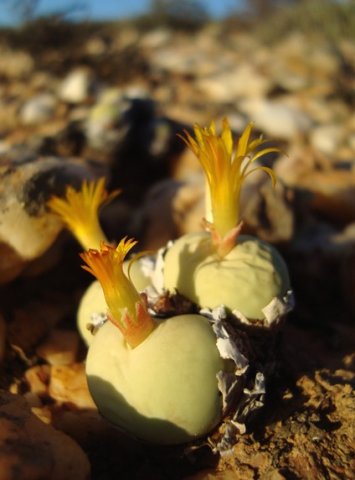Conophytum calculus

Author: Ivan Lätti
Photographer: Judd Kirkel Welwitch
Conophytum calculus, in Afrikaans commonly called marmerknopies (little marble buttons) or rooibekkies (little red maws), is a perennial dwarf succulent forming clumps that reach heights to 3 cm. The plants can be extremely long-lived, some in captivity apparently tended for 50 years.
The almost globular to oblong or ellipsoid single leaf bodies or plant bodies are pale green, grey green to chalky blue with short, central fissures on top. These leaf bodies can hardly be recognised as the leaf-pairs of earlier, ancestral plants. The leaf bodies become about 2,5 cm in diameter. During the hot summer months the leaves dry, the old, white and papery leaf skins retained over the emerging new leaves as protective cloaks. This continues until discarded bit by bit later for the new leaves to photosynthesise in winter growing.
The solitary flowers emerging from the leaf fissures during autumn are fragrant, opening at night. This strongly favours the chances of moth pollinators, excluding diurnal operators. The sepals form a short, fleshy tube are visible in picture above the fissure. Bracts are present but concealed inside the leaf bodies. The narrowly oblong petals are yellow, golden or orange, sometimes tipped red or brown. Flower diameter is about 1,2 cm.
The five-lobed fruit capsules are hygrochastic, opening when it rains once they’re ripe and closing when dry again. In this way the seed release is partial and sequential, aligned with moisture presence, supporting successful germination of more seeds.
The species distribution is from the far northwest of the Western Cape, from the Knersvlakte to the west of the Northern Cape in Namaqualand and into Bushmanland to the northeast.
The habitat is arid, short scrubveld, often among quartz pebbles on slight slopes. The pebbles serve as ecological camouflage for the plants in habitat, shielding them from both herbivory, and thermal stress. Both the pebbles of particularly the Knersvlakte and the pale leaf bodies reflect heat away from the plants. The specific name, calculus, is a Latin word meaning pebble or stone, referring to this significant plant asset. The habitat populations of both subspecies are deemed critically endangered early in the twenty first century, due to the great popularity of these plants with illegal collectors from veld populations, boosted by strong demand in the international succulent market (Van Jaarsveld, et al, 2006; Le Roux, et al, 2005; Smith, et al, 1998; iNaturalist; Wikipedia; https://llifle.com; http://redlist.sanbi.org).

